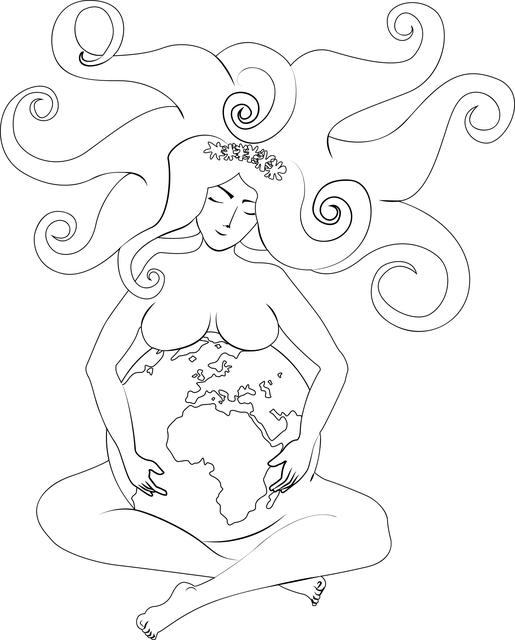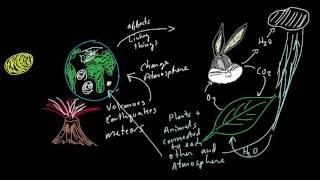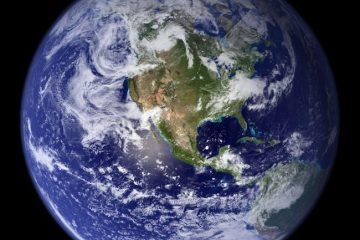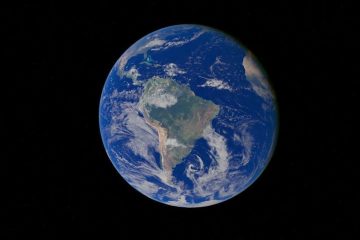Table of Contents
- Exploring the Foundations of Gaia Theory and Its Scientific Roots
- Real-World Examples of Gaia Theory in Action Across Ecosystems
- The Role of Human Activity in Influencing Gaias Balance
- Practical Applications of Gaia Theory for Sustainable Practices
- Understanding the Implications of Gaia Theory for Environmental Policy
- Q&A
- Closing Remarks

Exploring the Foundations of Gaia Theory and Its Scientific Roots
The Gaia Theory, first articulated by James Lovelock in the 1970s, posits that Earth functions as a self-regulating, complex system. This groundbreaking perspective shifts the traditional view of the environment as merely a collection of separate entities, suggesting instead that biotic and abiotic components collaborate to maintain the conditions necessary for life. Through intricate feedback loops, various elements—such as the atmosphere, oceans, and terrestrial habitats—interact in ways that promote the stability and resilience of ecological systems.
At its core, the theory integrates insights from multiple scientific disciplines including biology, environmental science, and geochemistry. For example, microorganisms in the soil play a crucial role in nutrient cycling, influencing plant growth and ultimately impacting the entirety of the food web. Further, studies have shown that forests can regulate local climate, promoting rainfall and cooling effects that benefit surrounding ecosystems. Thus, the Gaia Theory embraces a holistic view of Earth, emphasizing the interconnectedness of life and the environment.
The scientific roots of the Gaia Theory are grounded in several key concepts, including homeostasis and feedback mechanisms. Homeostasis refers to the ability of a system to remain stable despite external changes, while feedback mechanisms involve the responses that systems exhibit to maintain equilibrium. Below is a table that outlines these principles:
| Concept | Description |
|---|---|
| Homeostasis | The tendency of ecological systems to regulate themselves, ensuring stability. |
| Feedback Mechanisms | Interactions between system components that help maintain balance and resilience. |
understanding these foundational elements deepens our comprehension of how life on Earth is sustained and encourages us to reconsider our role within this dynamic system. By appreciating the delicate interdependence that underpins our planet, we can foster more sustainable interactions with the environment, reflecting the essence of the Gaia Theory in our daily practices.
Real-World Examples of Gaia Theory in Action Across Ecosystems
One of the most fascinating demonstrations of Gaia Theory can be seen in the Amazon Rainforest, where the intricate interplay between flora and fauna fosters a self-regulating ecosystem. Trees in this lush environment not only provide oxygen but also influence rainfall patterns through transpiration. The moisture released into the atmosphere creates a cooling effect that leads to local precipitation, sustaining the very ecosystem that cultivates it. This cyclical relationship exemplifies how vegetation can control climatic conditions, promoting biodiversity and resilience.
In marine ecosystems, coral reefs offer another vivid representation. Corals are symbiotic structures formed from the complex relationships between coral polyps and algae known as zooxanthellae. These tiny organisms not only provide essential nutrients through photosynthesis but also pump oxygen into the water, which is critical for marine life. The health of coral reefs directly impacts fish populations and even coastal protection, illustrating a tightly intertwined system where every component, from the smallest microbe to the largest predator, plays a vital role in maintaining ecological balance.
| Component | Role in Ecosystem |
|---|---|
| Trees | Regulate climate and provide habitat |
| Coral | Support biodiversity and coastal protection |
| Algae | Produce oxygen and nutrients |
| Fish Species | Maintain reef health and food chains |
Another compelling example can be found in the Arctic tundra, where the interplay between permafrost and vegetation creates a unique climate system. The insulating layer of permafrost regulates temperatures and stabilizes water drainage, which influences plant life and animal migrations. As vegetation grows, it helps retain soil and moisture, further perpetuating the tundra’s climate. This showcases how even extreme environments can exhibit self-regulating phenomena that align perfectly with Gaia Theory, emphasizing the interconnectedness of biotic and abiotic factors.

The Role of Human Activity in Influencing Gaias Balance
The intricate web of interactions within Earth’s ecosystems showcases the delicate balance that governs our planet. Human activity plays a pivotal role in influencing this balance, often through both positive and negative impacts. Urbanization, industrialization, and agricultural practices have transformed landscapes and shifted ecological dynamics. As individuals and communities harness natural resources, they inadvertently alter biogeochemical cycles, temperature regulation, and biodiversity. These actions disrupt the equilibrium critical for sustaining life, showcasing our duty to tread carefully on this shared planet.
One significant aspect of human influence is the emission of greenhouse gases, which significantly affects climate patterns. Over the past century, activities such as fossil fuel combustion and deforestation have increased CO2 levels, leading to global warming. This shift not only raises average temperatures but also drives extreme weather events, ocean acidification, and rising sea levels. To further illustrate this impact, consider the following table that highlights key human activities and their corresponding effects on Gaia:
| Human Activity | Impact on Gaia |
|---|---|
| Deforestation | Loss of biodiversity, increased carbon emissions |
| Industrial Pollution | Air and water quality degradation, health risks |
| Urbanization | Habitat destruction, altered weather patterns |
| Agricultural Expansion | Soil degradation, water scarcity |
Conversely, human endeavors can also foster resilience and restoration within ecosystems. Initiatives aimed at conservation, habitat restoration, and sustainable practices highlight our capacity for positive change. Actions such as reforestation, renewable energy adoption, and wildlife protection counterbalance some negative effects, helping to restore Gaia’s harmony. By carefully considering our actions and integrating sustainability into daily life, we can participate in maintaining Earth’s delicate balance and ensure a healthier planet for future generations. Embracing this responsibility not only benefits ecosystems but also promotes our long-term well-being.

Practical Applications of Gaia Theory for Sustainable Practices
Gaia Theory posits that the Earth functions as a self-regulating system, where living organisms interact with their inorganic surroundings to maintain conditions conducive to life. This concept can be harnessed in numerous practical applications aimed at fostering sustainability. By understanding the interconnectedness of ecosystems, we can implement practices that promote ecological balance and resource efficiency.
Here are some practical applications of Gaia Theory:
- Permaculture Design: Utilizing the principles of natural ecosystems to create sustainable agricultural systems that mimic nature’s diversity.
- Holistic Management: A framework for making decisions that considers the entire ecological system, optimizing land use while promoting soil health and biodiversity.
- Biomimicry: Designing products and systems inspired by nature’s time-tested patterns and strategies, leading to innovations that reduce environmental impact.
- Waste Reduction: Implementing circular economy principles that view waste as a resource, inspired by natural nutrient cycles.
To further illustrate how Gaia Theory can be applied, the following table presents examples of projects and initiatives:
| Project | Application | Outcome |
|---|---|---|
| Green Roof Initiatives | Urban biodiversity enhancement | Improved air quality and lower urban heat |
| Restoration of Wetlands | Water filtration and flood mitigation | Increased wildlife habitat and reduced flooding |
| Community Composting Programs | Waste reduction and soil enrichment | Enhanced local food production and soil health |

Understanding the Implications of Gaia Theory for Environmental Policy
Gaia Theory presents a fascinating perspective on the interconnectedness of life and the environment, suggesting that Earth’s biological and physical systems cooperate to maintain conditions conducive to life. This holistic view significantly impacts environmental policy by emphasizing the need for sustainable practices that recognize the symbiotic relationships within ecosystems. Policymakers who integrate this understanding can craft regulations that not only address immediate environmental challenges but also promote long-term ecological balance.
Incorporating Gaia Theory into environmental policy encourages a shift from a purely anthropocentric approach to one that values all life forms. For example, this might manifest in policies that protect not just individual species but entire ecosystems. Some practical implications include:
- Ecosystem-based management: Focus on the health of entire ecosystems rather than isolated species.
- Integrative land use planning: Encourage urban development that preserves natural habitats.
- Transboundary cooperation: Encourage nations to work together on shared environmental resources, promoting a global perspective on ecological health.
As jurisdictions adopt Gaia Theory principles, they may also begin to measure success through ecological indicators rather than traditional economic metrics. A table illustrating common frameworks that could redefine environmental success measures includes:
| Traditional Metric | Ecological Indicator |
|---|---|
| GDP Growth | Species Diversity Index |
| Industry Output | Carbon Sequestration Rates |
| Resource Harvest Levels | Ecosystem Resilience Assessments |
Ultimately, embracing the implications of Gaia Theory allows for a more integrated approach to environmental challenges, fostering policies that are reflective of our planet’s intricate web of life. By understanding and addressing the interconnectedness of natural systems, policymakers can create a framework that not only mitigates environmental harm but actively contributes to global sustainability.
Q&A
Q&A: Understanding Gaia Theory Through Examples
Q1: What is Gaia Theory?A1: Gaia Theory, developed by James Lovelock in the 1970s, proposes that the Earth operates as a self-regulating system. This theory suggests that living organisms interact with their inorganic surroundings to maintain conditions suitable for life. Essentially, the Earth, including its atmosphere, oceans, and biosphere, functions in harmony to sustain life.Q2: Can you provide a practical example of Gaia Theory in action?A2: A classic example of Gaia Theory is the regulation of Earth’s temperature. The relationship between photosynthetic organisms, such as trees and phytoplankton, and the atmosphere illustrates this well. When carbon dioxide levels rise due to volcanic eruptions or human activity, these organisms increase their photosynthesis to absorb more CO2, consequently lowering global temperatures. This interaction helps maintain a stable climate conducive to life.
Q3: How does Gaia Theory apply to ecosystems?A3: Gaia Theory can be seen in action within ecosystems, where various species interact and contribute to environmental balance. For instance, coral reefs are diverse ecosystems where corals, algae, fish, and invertebrates work together. The algae produce oxygen and food for the corals through photosynthesis, while the corals provide shelter and nutrients for the algae, showcasing how life forms collaborate to create a thriving environment.
Q4: What role do human activities play in Gaia Theory?A4: While humans are often viewed as disruptive forces in nature, Gaia Theory emphasizes our interconnectedness with the planet. For instance, urban gardening initiatives show how humans can positively impact local ecosystems by increasing biodiversity, improving air quality, and even aiding in carbon capture. This reflects the concept that, while our actions can threaten balance, they also have the potential to restore it.
Q5: Are there any criticisms of Gaia Theory?A5: Yes, some scientists criticize Gaia Theory for being overly anthropocentric or teleological, suggesting that it implies Earth has a purpose rather than a natural process. Critics argue that while life influences its environment, it does not necessarily create a self-regulating system. However, the theory provides a valuable framework for understanding the complex interactions within Earth’s systems and emphasizes the importance of preserving these relationships.
Q6: How can individuals and communities engage with Gaia Theory?A6: Individuals and communities can engage with Gaia Theory by adopting sustainable practices. This includes supporting local food systems, participating in conservation efforts, and fostering biodiversity in urban areas through initiatives like community gardens or wildlife habitats. By recognizing our role within the Earth’s systems, we can contribute to a healthier planet that reflects the principles of Gaia Theory.
By exploring these questions and answers, readers can gain a deeper understanding of Gaia Theory and its relevance to everyday life, as well as the responsibilities we hold in maintaining the balance of our planet.



0 Comments